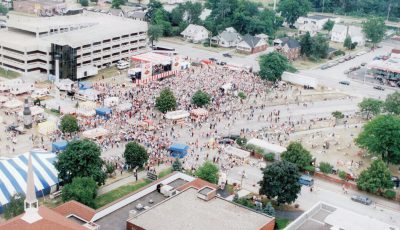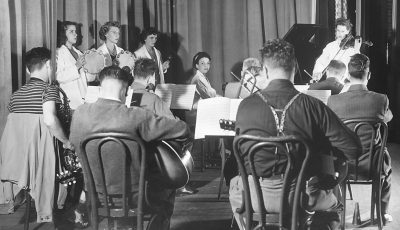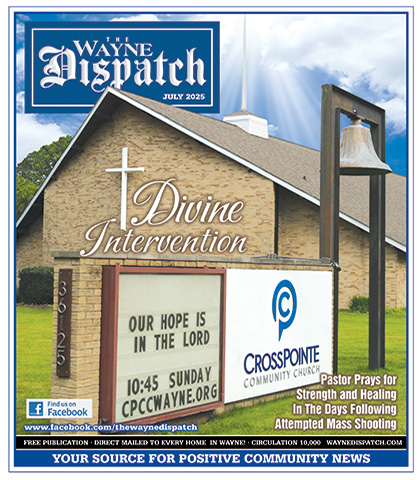State Wayne Theater celebrates 75th anniversary
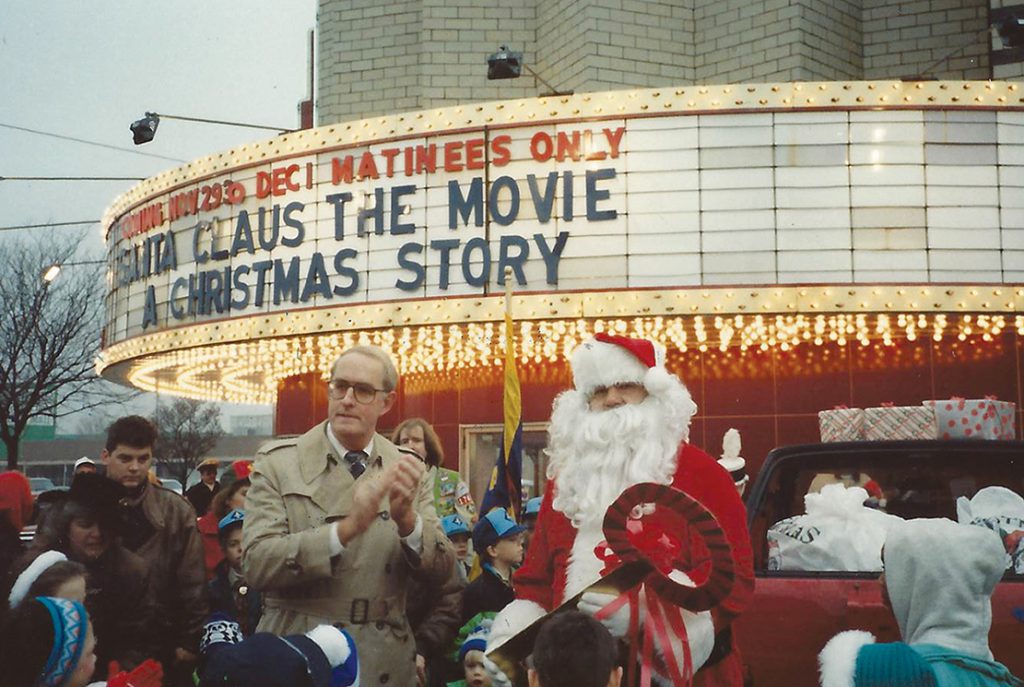
Mayor Pro-Tem Ed Phillips with Santa in the early 1990’s. Photo provided by the Wayne Historical Museum
By Courtney Conover – Let’s rewind and go back in time…
Back when a brand-new men’s tie sold for next to nothing (just over a buck); meanwhile, the bikini made its debut in Paris, France…
Back when both Dean Martin’s and B.B. King’s musical careers began, and Freddie Mercury, Dolly Parton, Steven Spielberg were born…
Back when average wages were $2,500 per year, monthly rent would set you back about 60 dollars per month, and with donuts costing 15 cents per dozen and eggs costing a mere 64 cents per dozen, feeding a small army breakfast on the cheap wasn’t out of the realm of possibility.
Oh, and then there’s this nugget: Tupperware began selling in department and hardware stores. (The company’s home parties wouldn’t begin until 1948, though.)
All these aforementioned cultural milestones happened quite a while ago—1946 to be exact—and that was also the year Wayne’s historic State Wayne Theater opened for business.
Currently known as the Phoenix State Wayne Theater, this movie house possesses a rich history that’s as storied as many of the movies that have been shown inside it. And the latest chapter is a celebratory one, indeed: this month—December 31 to be exact— the Phoenix State Wayne Theater turns 75.
“What I really like about the State Wayne is that it’s generational,” says Cory Jacobson, owner of Phoenix Theaters. “During a showing of the last Rocky film, Creed II, a man came in with his elderly father, who was well into his nineties. They came out of the theater and the father said that they’ve watched every Rocky film here since 1976. And when you think about that kind of history, where someone can go back over forty years, and they’ve followed a film series at that particular theater, I think that in itself is really an extraordinary thing.”
According to Tyler Moll, manager of the Wayne Historical Museum, the Phoenix State Wayne Theater holds a unique spot in this city’s overall landscape.
“Given the context of how many historic buildings Wayne has lost, the saving of that building—and its restoration and reopening—was really one of the highlights of historic preservation in Wayne,” says Moll.
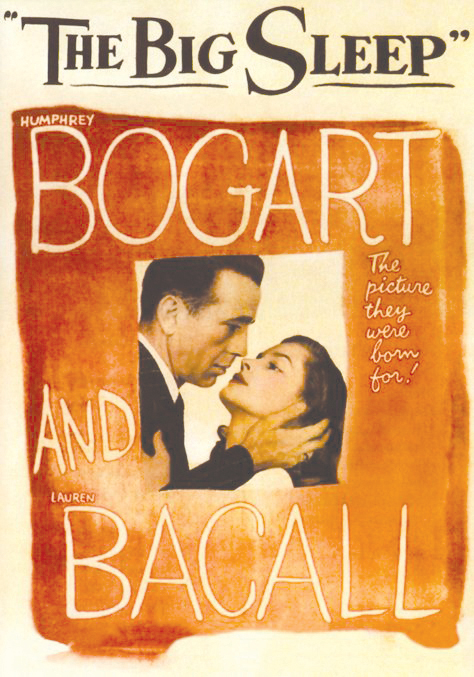
The “Big Sleep” was the first movie shown at the State Wayne Theater.
“If you walked out into the middle of Michigan Avenue—assuming there were no cars—and you looked in both directions as far as the eyes could see, I think you’d have a really hard time finding another building or business that’s been open for 75 years. In the same place, looking to the outside world much the same as it did 75 years ago,” says Jacobson, whose passion and enthusiasm for the theater is palpable.
And justifiably so: 75 years in business is nothing to sneeze at. Especially these days.
More on that in a minute. But, first, let’s explore how the theater got here.
The concept of bringing a new theater to the City of Wayne was the brainchild of Walter Shafer. The year was 1940, and Shafer and his family had already owned the Wayne Theater, which was also on Michigan Avenue. A functioning lumberyard existed a stone’s throw away, and the Shafers had decided that it would be the perfect site for the new theater, which was initially intended to replace the Wayne Theater.
And a name had been picked out, too.
“It was supposed to be called The Academy,” says Moll.
Land was purchased and plans were drawn up.
Then World War II happened. And that put a proverbial monkey wrench in everything.
But after the project’s pause, construction commenced and the cinder block and fireproof brick 1,500-seat auditorium with a single screen opened for business in 1946. It was called The State Theater because sometime between 1940 and 1946, the name The Academy had gone out the window. However, to distinguish the theater from nearby competitors—both the cities of Ann Arbor and Pontiac had movie theaters called State Theater—local newspapers referred to Wayne’s new movie house as State-Wayne in movie listings.
The name stuck.
During the years that followed, the State Wayne would undergo a wide spectrum of alterations and improvements, among them was a $75,000-upgrade, which replaced carpeting, seats, and upholstery in 1964. And what would become one of the theater’s most unique features—the Dragon Murals painted by Dutch artist Anton Mom—arrived on the scene as well.
But by the time the 1970s rolled around, the State Wayne had hit a rough patch: the advent of other movie houses—enter the term multiplexes—meant more competition from surrounding suburbs.
The theater closed in 1977. The Michigan Opry then leased the venue, which brought live country music shows to the theater.
That plan lasted a few years, and what followed in 1980 was a span of time Wayne residents—and residents of nearby communities—may remember quite fondly: 99-cent movie tickets.
Ah, yes. Those were the days.
But after decades of a solid run, the Shafer family decided to sell the theater to National Amusements in 1986. And the theater closed…again.
The re-opening in 1991, which was spearheaded by the City of Wayne, brings us to the modern era of State Wayne Theater, which, much like the previous years, has also seen its fair share of changes.
With the assistance of over $500,000 in Downtown Development Authority (DDA) funds, the city purchased and completely overhauled the State Wayne, which included replacing the two existing storefronts with restrooms. The theater was also divided into three screens and a live stage.
Then, several years later, the theater’s famed—and immensely personal—mural, called “Wayne History Mural,” was created by David Fichter and Joshua Winer with assistance from Anthony Ivezaj. The hand-painted work of art, which is arguably now as well-known as the building’s original marquee, covers the vast majority of the theater’s east exterior wall. The eye-catching art-deco painting style (called “Trompe L’oeil) serves as a fitting tribute to Wayne’s past and present. The mural was dedicated on October 16, 2007, and re-dedicated on October 28, 2008.
But unlike the theater’s picturesque surface, the bottom line regarding the theater’s finances was anything but pretty.
The theater was hemorrhaging money, and something had to be done.
In July 2014 Wayne City Council voted 6-0 to sell the State Wayne Theater to Insight Holdings II, LLC, which was related to Phoenix Theatres. Phoenix Theatres had been operating the theater for the city since August 2012. The sale became official in September 2014.
In 2015 Phoenix Theatres replaced all 1,152 incandescent marquee lamps with new LED-style, energy-efficient lamps on the State Wayne Theater’s marquee, a move that reduced the total wattage from 12,672 watts of power to just 1,613. “Great care was taken in selecting a new style of LED lamp that was similar in appearance to the original yet give us greater efficiency and a new crisper look,” said Jacobson.
More striking enhancements soon followed: new carpeting, Christie digital projectors and 7.1 Dolby Digital sound in every auditorium, and two auditoriums were given larger picture sizes for a markedly noticeable wall-to-wall digital image. Then, in the summer of 2017, auditorium one received the upgrade of a Trinnov audio system, which features 3-D sound technology. Additionally, the auditorium’s screen was changed over to a Harkness micro-perforated screen, which produced exceptional quality.
And then things got really, really…comfortable.
Back in the fall of 2014 Phoenix Theatres took the theater’s seating to a whole new luxurious level with the installation of seats that fully recline. And in late fall of 2018, those seats got even better when they became heated.
“I think their efforts to really modernize—the new seats, the digital projectors, etc.—doing that kind of stuff is really going to keep them ahead of the game and keep the theater successful,” says Moll.
Furthermore, in early 2020, the theater began offering reserved seating and debuted a new mobile app, which enabled patrons to order tickets online. To gain entry, patrons simply had to have the barcode on their cellphone scanned upon arrival.
Yes, things were cruising along for the newly re-named Phoenix State Wayne Theater.
But what followed would rock not only the movie industry—but our world as we knew it.
Jacobson remembers, “We were all excited about the launch [of the app],” Jacobson remembers…and then we ended up closing in March [2020] due to pandemic. It became readily apparent to us in about June [2020] that this [COVID-19] was a serious problem that was not going to resolve itself quickly.”
The Phoenix State Wayne would oscillate between various levels of openness until February of 2021 when they re-opened with full concessions.
Then, finally, came a signal of hope.
“It all started to break this summer, almost synonymously with the vaccination rate,” says Jacobson. “As the rate increased, and as things returned to normalcy here in Michigan and throughout the country, we’ve seen more and more pictures become released.”
The theater has even seen the return of “Rocky Horror Picture Show Experience,” with Wayne’s live, unique shadow cast. The show, which launched in 2012, is inspired by the 1975 20th Century Fox musical comedy horror film, The Rocky Horror Picture Show and is presented by The Michigan Rocky Horror Preservation Society on the second and fourth Saturday of every month.
But, wait, it gets better.
Says Jacobson, “The State Wayne actually exceeded its October business [this year] from [October] 2019. We can’t really look at October 2020 because we were closed, but if you compare October 2019 to October 2021, we had more attendance, more customers, higher box office revenues, and higher concession revenues [in 2021]. So, that is a wonderful turn of events.”
And that brings us to the theater’s seventy-fifth anniversary.
Perhaps the biggest celebratory act isn’t taking place inside, it’ll, in fact, be outside: just last month, Jacobson signed an agreement with the State Wayne’s sign company to change all the (yellow and quite aged) faces on the front of the marquee.
“It’s like if you haven’t gone to the dentist for a long period of time, and you need to get your teeth cleaned,” explains Jacobson. “We’ll replace all of the electronics inside with new LEDs.”
If any marquee deserves such tender loving care, it’s this one.
A little-known fact: If one were to unroll the half-circle-shaped marquee and put a tape measure to it, he or she would find that the marquee is the largest in Michigan.
But as far as the theater’s anniversary celebration goes, that’s just the beginning.
From December 3 through December 9, tickets to the famed holiday classic, The Polar Express, will be just $1 for all patrons during all viewings.
And, currently, Jacobson says that a party—much like the one held in honor of the theater’s seventieth anniversary—is in the works for spring 2022. Says Jacobson, “We’re going to try to re-enact that party. We brought some of the employees from every decade the theater was open, and I want to do that again.”
And that’s arguably the best anniversary gift any movie-goer could possibly receive.


